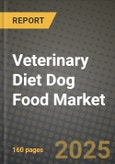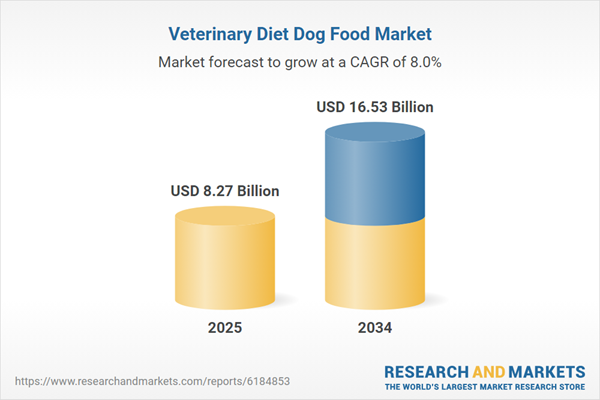Veterinary Diet Dog Food Market
The Veterinary Diet Dog Food market encompasses prescription-only and vet-recommended formulas designed to manage specific conditions - gastrointestinal sensitivity, dermatologic/food allergy, urinary health, renal and hepatic support, weight management and metabolic control, joint and mobility, cardiac, diabetes, and convalescence. Formats span dry kibble, wet pâté/stews, hydrolyzed and novel-protein diets, high-fiber and low-fat GI profiles, low-purine/low-oxalate urinary SKUs, omega-3-enriched renal/cardiac lines, fresh/frozen subscriptions, and condition-matched treats. Demand is propelled by pet humanization, longer canine lifespans with multimorbidity, rising allergic/dermatologic presentations, and veterinarians’ need for nutrition-as-therapy with measurable outcomes. Product development focuses on precisely balanced macronutrients, amino acid and fatty-acid targets (EPA/DHA), tailored mineral/urine chemistries, multi-fiber and prebiotic blends for gut health, highly digestible protein matrices, and palatability systems that preserve therapeutic constraints. Competitive dynamics include global pet-nutrition majors with vet-exclusive portfolios, specialist formulators in hydrolyzed/novel proteins, fresh/freeze-dried entrants with veterinary oversight, and tele-vet platforms integrating diet dispensing and adherence. Route-to-market is anchored in clinics and pet specialty with Rx verification, complemented by e-commerce autoship and home delivery. Headwinds include scrutiny of “prescription” positioning, price sensitivity versus grocery premium diets, counterfeit/leakage into unauthorized channels, and supply security for specialty ingredients (hydrolyzed proteins, fish oils). As clinics adopt outcome-based care and owners seek clear guidance, winners pair robust clinical substantiation and precise formulations with seamless vet workflows, reliable supply, transparent labeling, and digital adherence tools that improve acceptance, persistence, and quality-of-life metrics.Veterinary Diet Dog Food Market Key Insights
- Nutrition as first-line adjunct to chronic care
- Precision formulation over generic premiumization
- Microbiome-aware GI strategies scale across indications
- Allergy management moves from elimination to lifetime plans
- Weight and metabolic control require behavior design
- Renal/cardiac lines balance palatability with restriction
- Urinary health: chemistry first, compliance always
- Fresh/frozen and minimally processed with clinical guardrails
- Supply chain, QA, and recall resilience as table stakes
- Omnichannel with Rx control and adherence tooling
Veterinary Diet Dog Food Market Reginal Analysis
North America
Clinic-anchored prescribing with strong e-commerce autoship drives refills; owners expect clear condition matching and palatability variety. Allergy and GI lines lead velocity, with weight-management and urinary close behind. Regulatory scrutiny of claims and channel control shapes messaging and distribution. Tele-vet and nurse-led check-ins improve adherence. Retailers favor brands with robust QA, recall transparency, and counterfeit safeguards.Europe
Quality and compliance norms support clinician-led protocols and pharmacy/pet specialty fulfillment with Rx checks. Renal/cardiac and urinary portfolios are highly developed; hydrolyzed and limited-ingredient lines serve strong allergy caseloads. Sustainability (fish oil sourcing, packaging) and clear additive labeling influence listings. Multi-language education and strict batch documentation are expected. Vet-exclusive positioning remains a trust signal.Asia-Pacific
Rapid pet humanization and clinic expansion lift demand for GI, dermatology, and weight SKUs. Novel-protein interest rises where food allergies are prominent; fresh/frozen pilots appear in tier-one cities. E-commerce is dominant, requiring tight Rx verification and anti-diversion controls. Heat and humidity elevate palatability and shelf-life engineering needs. Localized flavors/textures and small pack sizes aid trial.Middle East & Africa
Growth is concentrated in urban clinics and premium retailers; urinary and dermatology lines are early leaders. Heat-related intake issues make wet formats and hydration guidance important. Halal considerations and Arabic/French labeling support adoption. Reliable cold-chain and on-time replenishment win tenders with hospital groups. Education on true elimination trials reduces premature product switching.South & Central America
Urbanization and expanding veterinary access support GI, allergy, and weight portfolios at accessible price tiers. Currency volatility favors predictable subscription pricing and clinic loyalty programs. Smaller bags and sachets increase affordability and trial. Spanish/Portuguese education, clinic staff coaching, and cross-format parity (kibble/wet/treats) sustain adherence. Strong distributor service and QA credibility drive brand preference.Veterinary Diet Dog Food Market Segmentation
By Type
- Weight Management
- Digestive Care
- Diabetes
- Skin & Coat Care
- Allergy & Immune System Health
- Kidney Health
- Hip & Joint Care
- Illness and Surgery Recovery Support
- Others
By Application
- Senior
- Adult
- Puppy
Key Market players
Colgate-Palmolive Company (Hill’s Pet Nutrition), Nestlé Purina PetCare Company, Mars Incorporated (Mars Petcare / Royal Canin), General Mills Inc., Diamond Pet Foods Inc., Virbac S.A., Veterinary Nutrition Group, Farmina Pet Foods, JustFoodForDogs, EmerAid LLC, Dechra Pharmaceuticals plc, Spectrum Brands Pet Care (IAMS/Eukanuba), Blue Buffalo Company Ltd., Hill’s Pet Nutrition (Prescription Diet), Purina Pro Plan Veterinary Diets, Waltham Centre for Pet Nutrition (Mars), Teva Animal Health (now Ceva Animal Health), Nutramax Laboratories Inc., H&H Group Inc. (Zesty Paws), and Vetoquinol S.A.Veterinary Diet Dog Food Market Analytics
The report employs rigorous tools, including Porter’s Five Forces, value chain mapping, and scenario-based modelling, to assess supply-demand dynamics. Cross-sector influences from parent, derived, and substitute markets are evaluated to identify risks and opportunities. Trade and pricing analytics provide an up-to-date view of international flows, including leading exporters, importers, and regional price trends.Macroeconomic indicators, policy frameworks such as carbon pricing and energy security strategies, and evolving consumer behaviour are considered in forecasting scenarios. Recent deal flows, partnerships, and technology innovations are incorporated to assess their impact on future market performance.
Veterinary Diet Dog Food Market Competitive Intelligence
The competitive landscape is mapped through proprietary frameworks, profiling leading companies with details on business models, product portfolios, financial performance, and strategic initiatives. Key developments such as mergers & acquisitions, technology collaborations, investment inflows, and regional expansions are analyzed for their competitive impact. The report also identifies emerging players and innovative startups contributing to market disruption.Regional insights highlight the most promising investment destinations, regulatory landscapes, and evolving partnerships across energy and industrial corridors.
Countries Covered
- North America - Veterinary Diet Dog Food market data and outlook to 2034
- United States
- Canada
- Mexico
- Europe - Veterinary Diet Dog Food market data and outlook to 2034
- Germany
- United Kingdom
- France
- Italy
- Spain
- BeNeLux
- Russia
- Sweden
- Asia-Pacific - Veterinary Diet Dog Food market data and outlook to 2034
- China
- Japan
- India
- South Korea
- Australia
- Indonesia
- Malaysia
- Vietnam
- Middle East and Africa - Veterinary Diet Dog Food market data and outlook to 2034
- Saudi Arabia
- South Africa
- Iran
- UAE
- Egypt
- South and Central America - Veterinary Diet Dog Food market data and outlook to 2034
- Brazil
- Argentina
- Chile
- Peru
Research Methodology
This study combines primary inputs from industry experts across the Veterinary Diet Dog Food value chain with secondary data from associations, government publications, trade databases, and company disclosures. Proprietary modeling techniques, including data triangulation, statistical correlation, and scenario planning, are applied to deliver reliable market sizing and forecasting.Key Questions Addressed
- What is the current and forecast market size of the Veterinary Diet Dog Food industry at global, regional, and country levels?
- Which types, applications, and technologies present the highest growth potential?
- How are supply chains adapting to geopolitical and economic shocks?
- What role do policy frameworks, trade flows, and sustainability targets play in shaping demand?
- Who are the leading players, and how are their strategies evolving in the face of global uncertainty?
- Which regional “hotspots” and customer segments will outpace the market, and what go-to-market and partnership models best support entry and expansion?
- Where are the most investable opportunities - across technology roadmaps, sustainability-linked innovation, and M&A - and what is the best segment to invest over the next 3-5 years?
Your Key Takeaways from the Veterinary Diet Dog Food Market Report
- Global Veterinary Diet Dog Food market size and growth projections (CAGR), 2024-2034
- Impact of Russia-Ukraine, Israel-Palestine, and Hamas conflicts on Veterinary Diet Dog Food trade, costs, and supply chains
- Veterinary Diet Dog Food market size, share, and outlook across 5 regions and 27 countries, 2023-2034
- Veterinary Diet Dog Food market size, CAGR, and market share of key products, applications, and end-user verticals, 2023-2034
- Short- and long-term Veterinary Diet Dog Food market trends, drivers, restraints, and opportunities
- Porter’s Five Forces analysis, technological developments, and Veterinary Diet Dog Food supply chain analysis
- Veterinary Diet Dog Food trade analysis, Veterinary Diet Dog Food market price analysis, and Veterinary Diet Dog Food supply/demand dynamics
- Profiles of 5 leading companies - overview, key strategies, financials, and products
- Latest Veterinary Diet Dog Food market news and developments
Additional Support
With the purchase of this report, you will receive:- An updated PDF report and an MS Excel data workbook containing all market tables and figures for easy analysis.
- 7-day post-sale analyst support for clarifications and in-scope supplementary data, ensuring the deliverable aligns precisely with your requirements.
- Complimentary report update to incorporate the latest available data and the impact of recent market developments.
This product will be delivered within 1-3 business days.
Table of Contents
Companies Mentioned
- Colgate-Palmolive Company (Hill’s Pet Nutrition)
- Nestlé Purina PetCare Company
- Mars Incorporated (Mars Petcare / Royal Canin)
- General Mills Inc.
- Diamond Pet Foods Inc.
- Virbac S.A.
- Veterinary Nutrition Group
- Farmina Pet Foods
- JustFoodForDogs
- EmerAid LLC
- Dechra Pharmaceuticals PLC
- Spectrum Brands Pet Care (IAMS/Eukanuba)
- Blue Buffalo Company Ltd.
- Hill’s Pet Nutrition (Prescription Diet)
- Purina Pro Plan Veterinary Diets
- Waltham Centre for Pet Nutrition (Mars)
- Teva Animal Health (now Ceva Animal Health)
- Nutramax Laboratories Inc.
- H&H Group Inc. (Zesty Paws)
- and Vetoquinol S.A.
Table Information
| Report Attribute | Details |
|---|---|
| No. of Pages | 160 |
| Published | November 2025 |
| Forecast Period | 2025 - 2034 |
| Estimated Market Value ( USD | $ 8.27 Billion |
| Forecasted Market Value ( USD | $ 16.53 Billion |
| Compound Annual Growth Rate | 8.0% |
| Regions Covered | Global |
| No. of Companies Mentioned | 20 |









